Search results for: 'bronze'
-
 Anglo-Saxon gilt bow brooch
Anglo-Saxon gilt bow broochA find from the Isle of Wight from the Migration Period. Beautiful testimonial of the settlement of Britain by the Anglo-Saxons.
Price: on request Roman Hod Hill brooch
Roman Hod Hill broochMade around the year 100 and found on the Isle of Wight, after the Roman conquest of Britain.
Price: on request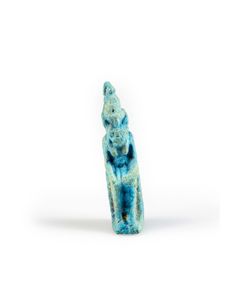 Egyptian faience figurine of the goddess Mut
Egyptian faience figurine of the goddess MutRare syncretic merging of the goddesses Mut and Sekhmet. The lion headed statuette is shown enthroned with the double crown of Upper and Lower Egypt.
Price: on request Gorgeous Roman Imperial fibula
Gorgeous Roman Imperial fibulaThe large bow is dominated by colourful enamel. It is a brooch type that developed during the 1st cent. AD in Central Europe.
Price: on request Neolithic thick butted axe head
Neolithic thick butted axe headKlinge eines dünnblattigen Dicknackenbeils. Trapezförmiger Körper aus schönem grauen Flint mit kleinen Einschlüssen. Ganggrabzeit bis Dolchzeit.
Price: on request Spitznackiges Beil der Älteren Trichterbecherkultur
Spitznackiges Beil der Älteren TrichterbecherkulturSpitzovales Längsprofil, grob bearbeitete Seiten, teilweise poliert. Typische für die Ältere Trichterbecherkultur, 4200 bis 3300 v. Chr.
Price: on request Trapezförmiger Beilkopf der Trichterbecherkultur
Trapezförmiger Beilkopf der TrichterbecherkulturFein polierte Breitseiten, unpolierte Schmalseiten. Schöner Flint mit heller Steinader an der Schneide. Gefunden um 1900 in Schackendorf, Schleswig-Holstein.
Price: on request Roman plate brooch
Roman plate broochBeautiful example with orange and turquoise enamel. A find from 2nd century Roman Britain.
Price: on request Anglo-Saxon bow brooch
Anglo-Saxon bow broochA find from the Isle of Wight from the Migration Period. Beautiful testimonial of the settlement of Britain by the Anglo-Saxons.
Price: on request Gallo-Roman animal fibula
Gallo-Roman animal fibulaZoomorphe Fibel mit Wildtier als Motiv. Schmuckstück mit religiöser Symbolik, vergleichbar einem Kreuzanhänger bei heutigen Christen. Gefertigt im 1. bis 3. Jh. n. Chr. in Gallien.
Price: on request Roman sandal sole type fibula
Roman sandal sole type fibulaDie Form wird in der Literatur als Schuh- oder Sandalensohle bezeichnet. Der sehr dekorative Fibeltyp war extrem beliebt und im zweiten Jahrhundert weit verbreitet. Er stammt aus den nördlichen römischen Provinzen.
Price: on request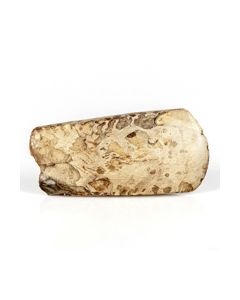 Neolithic thin butted axe head
Neolithic thin butted axe headAxe from the Early Neolithic is made of beautiful reddish brown flint with inclusions. Found in Northern Germany.
Price: on request Roman discus fibula with color glass paste
Roman discus fibula with color glass pasteSpannende Fibel mit Sterndekor und Glaspaste. Eine Weiterentwicklung keltischen Kunsthandwerks in der Zeit römischer Herrschaft. Gut dokumentierter Typ aus dem 2. Jh. v. Chr. mit Verbreitung in weiten Teilen Europas.
Price: on request Sumerian foundation cone from Uruk
Sumerian foundation cone from UrukSmall conoid clay nail with cuneiform inscription. From the main temple of Uruk, that is also mentioned in the Epos of Gilgamesh. Circa 3rd Millenium BC.
Price: on request Marc Antony legionary Denarius from Wishanger hoard
Marc Antony legionary Denarius from Wishanger hoardFound 2021 in East Hampshire, UK. The hoard is a very impressive proof of the fact that coins were in circulation for up to several centuries in the Roman era.
Price: on request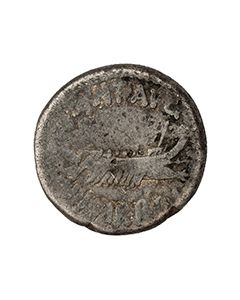 Marc Antony legionary Denarius from Wishanger hoard
Marc Antony legionary Denarius from Wishanger hoardFound 2021 in East Hampshire, UK. The hoard is a very impressive proof of the fact that coins were in circulation for up to several centuries in the Roman era.
Price: on request Vespasian denarius from Wishanger hoard
Vespasian denarius from Wishanger hoardFound 2021 in East Hampshire, UK. The hoard is a very impressive proof of the fact that coins were in circulation for up to several centuries in the Roman era.
Price: on request Marc Antony legionary Denarius from Wishanger hoard
Marc Antony legionary Denarius from Wishanger hoardLEG V or X. Found 2021 in East Hampshire, UK. The hoard is a very impressive proof of the fact that coins were in circulation for up to several centuries in the Roman era.
Price: on request Roman Republican denarius from Wishanger hoard
Roman Republican denarius from Wishanger hoardAnonymous, 2nd century BC. Found 2021 in East Hampshire, UK. Best condition of the five Marc Antony denarii in the hoard. The hoard is a very impressive proof of the fact that coins were in circulation for up to several centuries in the Roman era.
Price: on request Roman Republican denarius with galley from Wishanger hoard
Roman Republican denarius with galley from Wishanger hoardObverse showing janiform heads of the Dioscuri. Found 2021 in East Hampshire, UK. The hoard is a very impressive proof of the fact that coins were in circulation for up to several centuries in the Roman era.
Price: on request Roman Republican denarius of Renius from Wishanger hoard
Roman Republican denarius of Renius from Wishanger hoardBiga driven by goats on reverse. Found 2021 in East Hampshire, UK. The hoard is a very impressive proof of the fact that coins were in circulation for up to several centuries in the Roman era.
Price: on request Vespasian denarius from Wishanger hoard
Vespasian denarius from Wishanger hoardBeautiful dark patina. Reverse showing yoke of oxen. Found 2021 in East Hampshire, UK. The hoard is a very impressive proof of the fact that coins were in circulation for up to several centuries in the Roman era.
Price: on request Augustus denarius from Wishanger hoard
Augustus denarius from Wishanger hoardReverse showing Caius Caesar galloping right, eagle between two vexilla behind him. Found 2021 in East Hampshire, UK. The hoard is a very impressive proof of the fact that coins were in circulation for up to several centuries in the Roman era.
Price: on request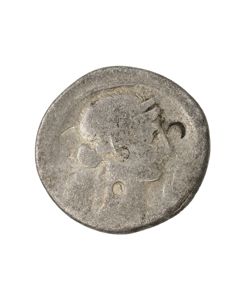 Octavian denarius from Wishanger hoard
Octavian denarius from Wishanger hoardShowing bust of Venus and Octavian in military dress. Found 2021 in East Hampshire, UK. The hoard is a very impressive proof of the fact that coins were in circulation for up to several centuries in the Roman era.
Price: on request Vespasian denarius from Wishanger hoard
Vespasian denarius from Wishanger hoardFound 2021 in East Hampshire, UK. The hoard is a very impressive proof of the fact that coins were in circulation for up to several centuries in the Roman era.
Price: on request Vespasian denarius from Wishanger hoard
Vespasian denarius from Wishanger hoardFound 2021 in East Hampshire, UK. The hoard is a very impressive proof of the fact that coins were in circulation for up to several centuries in the Roman era.
Price: on request Roman Republican L. Flaminius Cilo Denarius from Wishanger hoard
Roman Republican L. Flaminius Cilo Denarius from Wishanger hoardFound 2021 in East Hampshire, UK. The hoard is a very impressive proof of the fact that coins were in circulation for up to several centuries in the Roman era.
Price: on request Vespasian denarius from Wishanger hoard
Vespasian denarius from Wishanger hoardFound 2021 in East Hampshire, UK. The hoard is a very impressive proof of the fact that coins were in circulation for up to several centuries in the Roman era.
Price: on request Rare plate brooch with millefiori enamel
Rare plate brooch with millefiori enamelBrooch from Roman Imperial time, found in Roman Britain. It is an extremely rare and interesting type. The brooch is published in Richard Hattatt's standard work "Ancient Brooches and Other Artefacts" and discussed in detail.
Price: on request Vespasian denarius from Wishanger hoard
Vespasian denarius from Wishanger hoardThe reverse shows the urn of Vespasian on a column. Great patina. Found 2021 in East Hampshire, UK. The hoard is a very impressive proof of the fact that coins were in circulation for up to several centuries in the Roman era.
Price: on request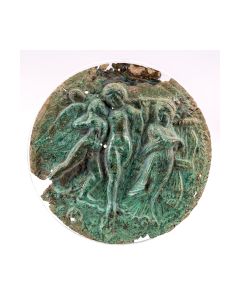 Published Etruscan mirror with Dionysian scene
Published Etruscan mirror with Dionysian sceneSubject of extended scientific analysis, one of only about 34 known specimen. High quality work, excellent condition. Described by Prof. Jucker as "small piece of art". From an old Swiss private collection. Overall in exceptional condition with thoroughly worked details.
Price: on request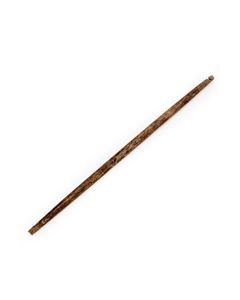 Egyptian spindle shaft made of wood
Egyptian spindle shaft made of woodExceptionally rare main piece of a hand spindle. A find from Thebes in Upper Egypt. From the reign of pharao Senusret II, around 1840 BC.
Price: on request Brooch from Roman Britain
Brooch from Roman BritainThis rare variant of the T-shaped brooches was found in Lechlade, Gloucestershire. It dates to the 1st or 2nd century AR. From the famous Hattatt collection and published in two standard works for ancient fibulae.
Price: on request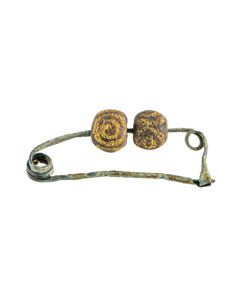 Early Italic brooch decorated with beads
Early Italic brooch decorated with beadsThere rare brooch type from northern Italy is based on predecessors from Greece. The piece is from the famous Richard Hattatt collection and is published in two of his works.
Price: on request Celtic penannular brooch
Celtic penannular broochPossibly made by the Celtic Durotriges tribe under Roman rule in Britain. The piece is published in two books by Richard Hattatt.
Price: on request Dolphin brooch from Roman Britain
Dolphin brooch from Roman BritainThe so-called dolphin brooch is very British. This specimen was probably made by the Celtic Corieltauvi tribe, shortly after the arrival of the Romans in the middle of the 1st century. Published in two works by Richard Hattatt.
Price: on request

